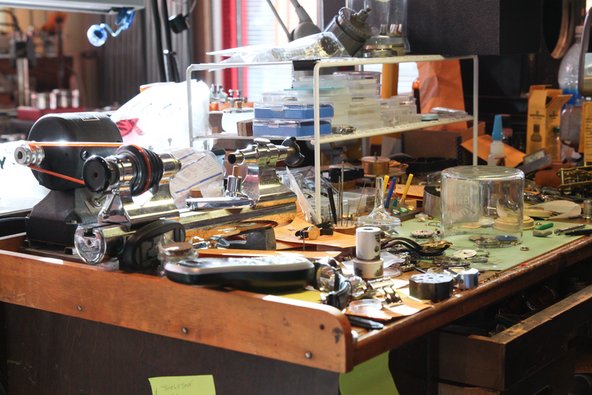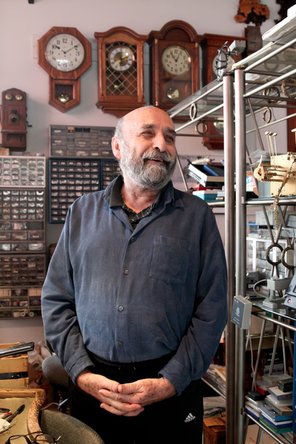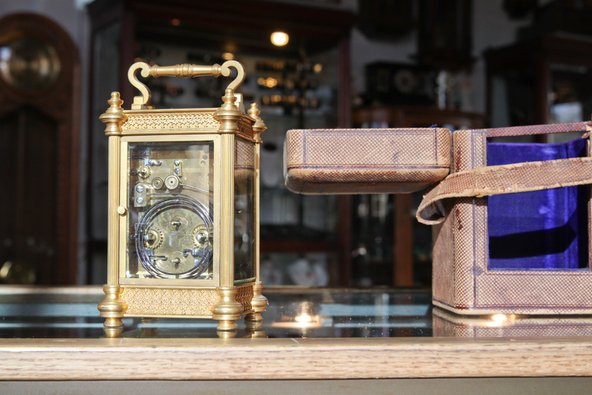Stepping behind the display cases of Ali Athari’s San Luis Obispo watch and jewelry store is like changing dimensions. Lavish watches and jewelry glisten in their cases only feet away, but they are only the facade—intricate disguises designed to hide the real artistry: the watchmaker’s workshop.
Ali is a lifelong student of watch design and repair, and it shows. The shelves of his workspace are lined with antique tools, calibration machines, and measurement devices—all designed for the repair of ailing timepieces.


It’s an amazing collection, amassed over the course of decades.

He roots through the shelves and digs out an old machine that resembles something like a seismograph—except instead of measuring vibrations deep in the earth, it measures mechanical health. Ali explains, “This thing here is an antique. It does mechanically what a computer does today. It tells me how the watch works and how accurate parts of it are by giving me a graph, but this is from the 1920s, maybe 1910s.” Ali then shows me the relic in action. Its spindly arm dances back and forth. Ali reads the action like a cardiograph; it tells him how to bring the watches back to life.
Ali’s workshop is more than just functional—it’s a personal museum, only occasionally revealed to visitors. That’s not to say that Ali lives in the past. His collection encompasses the full evolution of watch repair technology, from ancient to cutting-edge. Tools and measurement devices line his shelves like a physical timeline. And it’s fitting, really, that a watchmaker should chronicle historical time in timepieces.
Ali has been collecting parts and tools since his he was a boy in Iran.
“My mother used to tell all my aunts and whoever else wanted to hear it, that once a month she had to turn me upside down and shake my pockets empty. Because I would have all kinds of little things—pieces of metal with a hole in it or whatever, you know?” he says, laughing. “And she would say ‘What is this for?’ Well, somebody spent time making that, so it’s gotta be good for something.”
Ali never outgrew that mentality—that every single thing can be useful. That all objects have a function waiting to be discovered. That if someone took the time to make it, he can take the time to make it useful again.
Ali grabs a mysterious-looking leather box—clearly aged and well loved—from the top shelf. I’m not sure what I was expecting as he opened it, but it certainly wasn’t this: gold edges slide out of the felt-lined interior. “Wow,” I say; Ali smiles. The carriage clock is like something out another world, and it’s undeniably beautiful. The white porcelain front gleams against the casing—then Ali rotates the clock around. The sides are transparent, the complicated cogs, gears, and inner workings on full display.
This practice is actually fairly common among well-designed timepieces, because … why hide it? The real artistry of any analog watch isn’t just in the simplicity of the exterior—but in the beautifully orchestrated intricacies that make the thing function.
“Today, you get a little watch, electronic, and a push of button does the same thing, but it has a shelf life. Whereas this,” he nods to the carriage clock, “doesn’t have one. As long as you can service it, oil it, and clean it, it will last forever. This is probably 100 years old, easy.”
When I asked how we got the carriage clock, Ali casually answers, “Oh, it’s been in for a service here for almost a year. The owners don’t care how long it takes [to fix it] because there’s nobody else that will touch it.” Rest assured, Ali will find a way. Like I said—he knows that if somebody spent time making it, it’s worth spending some time to figure out how to fix it. Call me a romantic, but I think that’s a beautiful notion.
Although smartphones and wearables are gaining in popularity, I don’t think people like Ali will be out of a job any time soon. I think watches will stick around, because they’re beautiful mechanical marvels—a miniature world of cogs and gears operating in precise harmony. Just to tell you what time it is. And if your watch ever stops, bring it to Ali—he’ll probably be able to fix it. If he can’t figure it out or doesn’t have the right tool, I guarantee he’ll hang onto it until he does.
For the watchmaker, repairing a broken clock is just a matter of time.
Photos by Kristen Gismondi






0 Commenti